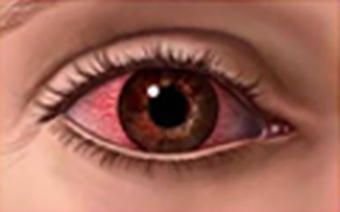Introduction
Dry eyes occur when the eyes either don’t make enough tears, or the quality of the tears produced is reduced, which means the tears can evaporate rapidly from the surface of the eye, allowing the eye to dry. Often, the reduced tear quality is a result of blockage or inflammation of the oil glands within the lid margin. When the surface of the eyes dry out, the eyes become inflamed. They appear red, and the whites of the eyes can appear to be pink and swollen. Normally, the eyes become very irritable. When seen on a microscope, using a fluorescent dye called fluorescein and a special cobalt blue light, the denuded surface areas can be seen as green specks on the surface of the eye.
Dry eyes can be divided into two broad categories.
If the main problem is a lack of tear production, then the term ‘keratoconjunctivitis sicca’ or ‘aqueous deficiency’ is used. However, if the main problem is poor quality of tears (but plenty of them) as a result of inflammation or blockage of the oil secreting glands in the lid margin, then the condition is called ‘obstructive meibomian gland disease’, more commonly referred to as blepharitis.
Who gets Dry Eye Syndrome?
It is more common in women than men, and is found most commonly in the over 60s age group. However, it can happen at any age.
In Dry Eyes, why do the eyes sometime water excessively? How can the eyes be dry if they are watering all the time? This a paradox which is explained as follows:
Blinking spreads a tear film over the surface of the eye – the eyelids do the opposite to what a windscreen wiper does on a car. The eyelids spread a thin film of tears over the front of the eye. When there are not enough tears, or if the quality of tears is poor, the surface of the eye becomes dry, and this causes inflammation.
Special receptors on the surface of the eye are then stimulated by this inflammation, which causes a ‘reflex tear production’. This leads to the main tear glands to literally ‘switch the tap on’ in an attempt to wet the dry surface. The result is often the production of excessive watery tears (as opposed to oily tears), which results in watering of the eyes.
Does Dry Eye Syndrome cause loss of vision?
Normally dry eyes causes no visual deterioration. However, in severe cases where the eye is allowed to dessicate, the cornea may scar and this could cause reduced vision.
How is Dry Eye Syndrome treated?
There is no absolute ‘cure’ for dry eye syndrome. However, most people can get significant relief from symptoms using a variety of treatments and measures.
Lid Margin Hygiene
If the underlying cause is blepharitis/lid margin disease, then treating this can often improve the ocular surface and reduce symptoms.
This can be done by simply applying a hot compress using hot tap water and a clean flannel to the eye each day, and then cleaning the lid margin with the water and flannel. Some people recommend using chemicals such as baby shampoo and sodium bicarbonate, but more often than not, these can cause ocular surface irritation, and so at least initially, are best avoided.
Lubricants
Regular lubrication in the form of gels or drops can help keep the surface of the eyes wet, and thus reduce symptoms. Often, this is combined with lid margin hygiene. There are a wide range of eye drops available – consult our optometrist for advice on which one to use.
Tear duct surgery
When there is severe dry eye with reduction in tear production, blocking the drainage of tears down the tear ducts can help keep the tears that are produced on the surface of the eye. Temporary plugs are normally inserted first. In some cases, permanent closure with surgical cautery may be used.
Other measures
Diet omega-3 oils and flax seed oil in the diet may help improve tear quality.
‘Think Blink’
When concentrating (e.g. using a computer or driving), we can blink up to 5 times less often, leading to increased tear evaporation. Remembering to blink more often can help keep the eye surface wet.
Humidifiers
Moist air leads to less evaporation of tears. Avoiding air conditioned environments and direct heat (e.g. an open fire or heat from a cooker) can help for the same reason.


What are the symptoms of Dry Eye Syndrome?
The symptoms can be extremely variable, causing anything from mild irritation to severe discomfort.
Dry eye symptoms include:
What causes Dry Eye Syndrome?


